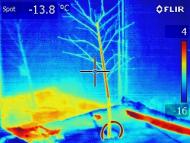As a research group, we are broadly interested in the ecological and evolutionary dynamics of populations that experience environmental heterogeneity over various spatial and temporal scales. We seek to understand mechanistically how natural selection works in heterogeneous environments, the context dependency and many constraints on this process, and how this ultimately produces an adaptive response. Our research combines extensive sampling of natural populations and –omics level characterizations, laboratory-based classical and molecular genetics, and experimentation conducted in both the field and laboratory. Much of our work is centered on testing the functional significance of identified molecular polymorphism: establishing concrete links between allelic variation, physiologically mediated performance, and the differential fitness of genotypes among environments. Currently our work focuses on Drosophila. While Drosophila has long been a model system in biology, it remains underutilized in ecological genetics; very little is known about its natural history, basic ecology, and evolutionary dynamics outside the laboratory.
Climatic Adaptation
One of our major interests is how natural populations evolve adaptively in response to climate and associated factors, and how evolutionary/ecological dynamics are affected by a changing climate. Over the past several years and in ongoing collections, we have sampled D. melanogaster and D. simulans populations along latitudinal transects in the eastern U.S. (Maine to Florida) and across seasons (May to December) in local Pennsylvania orchards. The ultimate goals are to use this model system to generate a comprehensive, mechanistic understanding of the evolutionary response to climate and to generate predictions regarding the evolutionary response of natural populations to anthropogenic climate change.
 |
 |
 |
|
| In temperate orchards, such as the peach orchards here, various environmental parameters are predictably distinct | Environmental parameters also vary predictably with season, and this elicits a rapid adaptive response | A typical under tree infrared thermal image showing temperature variations at macrolevel. | |
Some research objectives:
1. Identify those regions of the genome harboring polymorphism that covaries predictably with aspects of climate with latitude (e.g., Fabian et al. 2012) and season (e.g., Bergland et al. 2014).
2. Determine which phenotypes vary predictably with latitude and repeatedly with season in natural populations (e.g., Schmidt and Conde 2006; Schmidt and Paaby 2008).
3. Elucidate the genotype-phenotype map for traits of interest (e.g., Schmidt et al. 2008), and examine the functional significance of identified molecular polymorphism (e.g., Paaby et al. 2014).
Eco-evolutionary dynamics in natural populations
We have previously shown that Drosophila populations respond rapidly (within 10 generations) and adaptively to specific environmental variables that change with season. This rapid adaptation to seasonality provides a framework to investigate eco-evolutionary dynamics where evolutionary change alters ecological interactions, which in turn, feed back to alter evolutionary change. This research utilizes our experimental orchard, a facility we constructed for experimental evolution of large, outbred insect populations (see Orchard page!). We employ a powerful combination of field and laboratory experiments, and genomic and phenotypic analyses to address fundamental aspects of eco-evolutionary dynamics in wild populations of a model organism.
1. To determine the ecological consequences of rapid evolution in response to seasonal climate variation in wild populations ofDrosophila melanogaster.Our proximate research goals:
2. To elucidate how the ecological consequences of seasonal adaptation feed back to alter future evolutionary change.
3. To identify and characterize the genomic and phenotypic basis of rapid seasonal adaptation and determine which traits and genes mediate the eco-evolutionary dynamic.
4. To examine how inter-specific competition between D. melanogaster and D. simulans affect the eco-evolutionary dynamic.
The Genetic Basis and Evolutionary Dynamics of Diapause in Drosophila
Seasonality in temperate habitats poses a variety of environmental challenges to survivorship and population continuity. A common “solution” to this problem is the expression of diapause: a genetically determined syndrome cued by environmental signals that results in a shift to a physiological state that promotes survivorship during exposure to suboptimal conditions.
 |
 |
| Diapause and non-diapause ovaries of D. melanogaster |
Diapause is cued by exposure to low temperature and short photoperiod |
Our current work on diapause involves:
1) identifying genes that affect diapause expression, how they may functionally interact with previously identified diapause genes, and how these genes mediate life histories in natural populations;
2) outlining the photoperiodic response of diapause and the effects of the circadian clock on seasonal phenotypes;
3) further characterization of the gene couch potato and its role in mediating environmental perception and the neuroendocrine response;
4) elucidating the transcriptome and proteome associated with diapause expression;
5) investigating how diapause and the underlying genetic variance for diapause expression affect physiology, senescence, and life histories.





